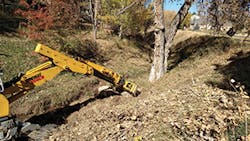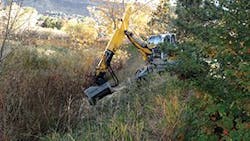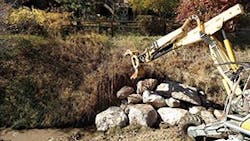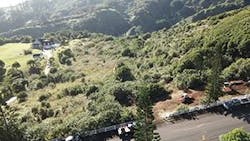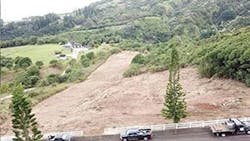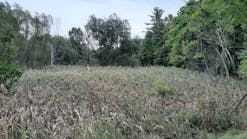Everyone knows that established vegetation is one of the best stormwater management and erosion control tools that can be found. Nothing beats vegetation for slowing water flow, cleaning pollutants, and keeping sediment out of streams. But sometimes, the vegetation itself becomes the problem. Thick, heavy vegetation can block views along highways, clog up detention ponds and structures, endanger electrical transmission lines, and restrict access to rights of way. Dead vegetation increases the risk of wildfire. Sometimes brush and high grass around residential properties must be cleared to increase the chance of a sale. Other times, lots need to be cleared before construction can begin.
A vegetation management plan might involve any of three means of clearing the area: chemical, physical, or biological. This article covers both physical and chemical strategies. Sometimes a combination of methods is used. A herbicide might be sprayed, and once the unwanted vegetation is dead, specialized equipment is used to grind it up and remove it. Often, the type of vegetation to be cleared will dictate the method of clearing and pruning.
Here are some case studies showing how vegetation management contractors have tackled the problems presented to them.
Colorado Stormwater Channels
Brian Pombo, president of All Mountain Construction based in Breckenridge, CO, shares details about a project his company recently completed. The City of Golden contracted the company to remove vegetation clogging city stormwater channels. In the past, the city had employed crews of up to 20 volunteers to hand-cut the channels. It also had tried chemicals, but that method didn’t work well except for controlling noxious weeds.
All Mountain Construction used a Menzi Muck spider excavator, also known as a walking excavator. It has four wheels with hydraulic cylinders that allow each wheel to adjust to changing terrain and slope.
Pombo used a DAH-100D attachment from Denis Cimaf of Roxton Falls, Quebec, to cut the vegetation. The attachment is boom-mounted, giving a long reach. The case consists of high-resistance steel plates equipped with high-resistance steel knives. The knives are connected by a single bolt and nut, making for easy replacement. The design of the knife post reduces the pressure on the knife, extending its life. Protective discs limit the amount that a knife is mulching, also extending knife life.
Denis Cimaf designs and fabricates vegetation removal attachments for excavators and skid steers. The company has attachments that fit excavators from 5 tons up to 35 tons. The company says that mulchers are gaining in popularity over the traditional crew of chainsaw operators. Denis Cimaf manufactures both the DAH line, boom-mounted for excavators and backhoes, and the DAF line, front-mounted for dedicated carriers and skid-steers.
The task of clearing vegetation from the stormwater channels took only a few days. In the past, the task would take weeks to do by hand.
Rob Gibson, stormwater supervisor for the City of Golden, was pleased with the work. He notes that the biggest challenge was the terrain: “We simply couldn’t get our traditional equipment in and out of the channels.” But the machines used by All Mountain Construction were able to maneuver up and down slopes and in places with near-vertical walls. This equipment also left a very minimal footprint on the stormwater channel bed.
Gibson says much of the growth in the stormwater channel is willows. The city has found that the small willows bend very easily and allow the water to pass over them, providing some protection for the stream bed. However, the bigger willows tend to pop out of the ground and wash away, causing two big problems. First, they get caught in pipes and culverts, causing blockages that result in flooding to nearby areas. Second, they leave behind large holes that are quickly scoured into bigger holes and that continue to erode with each rain event. During the project, Pombo fixed a large hole in a very deep ditch caused by the ripping out of a large willow.
The city plans to continue this method of clearing vegetation in the stormwater channels. Gibson notes that keeping the willows cut down every few years is important. The use of the equipment saves time and money because the need for manpower is greatly reduced.
Mississippi Cleanup
An RV site on the beach in southern Mississippi needed to be cleared of vegetation. The site was 20 acres—not an extremely large area, but there were complications. Ryan Ross of Shear View Mulching in Poplarville, MS, was contracted for the job. His equipment included a CMI C175 Twister II and a Caterpillar 311 excavator.
The CMI C175 Twister II, manufactured by Crawler Mulching Industries Inc. of Canada, is lightweight and designed for easy transport to the job site. The machine is 220 inches long, 100 inches high, and 68 inches wide. The working width is 55 inches and the entire assembly weighs 16,500 pounds. It can be transported without a large truck transport.
Two different-sized hydraulic mulching heads add versatility. Besides the standard, which is 55 inches in width, a 76-inch mulching head is available. The engine is a John Deere, 4045 T providing lots of power.
The CAT 311 is a small excavator with a lot of power and flexibility. The machine is 8.2 feet wide and 8.6 feet long. The gross engine power is 85 hp.
A two-man crew from Shear View Mulching handled the clearing operation. A big challenge was cement and debris left by old home sites. The crew had to be careful to avoid this debris when possible. There were also several homeless camps on the site.
Once the site was cleared of debris and vegetation, the construction of the RV park could begin. Ross advised that having the right equipment makes any job easier. He says of Crawler Mulching Industries, “They build dedicated machines specifically for mulching. It’s not a machine that was adapted to the mulching business.”
Maui Mulching
Edward Vares and his company, Vares Contracting, have been clearing vegetation on Maui for 10 years. Parts of the island of Maui get more than 300 inches of rain a year. Even the dry side of the island gets a substantial amount of precipitation. All this moisture leads to untamed growth of tropical vegetation. The growth blocks roads and rights of way and clogs farm plots and reservoirs. Some of the vegetation that needs to be removed includes invasive plant species.
Vares has the ability to undertake jobs ranging from small to medium to large. One part of his business is to clear farmlands for a family farm or for a mother-in-law cottage to be added to a lot. Vares does the heavy-duty clearing, and then the families can maintain their own lots.
The real estate industry is also a good customer for Vares Contracting. When vegetation has grown up around a house, buyers cannot see the potential of the property. Recently, Vares embarked on a project around a high-priced estate in the wetter part of Maui. The house had been foreclosed on three years earlier. No maintenance of the property had been done, so grass had grown up to 8 feet tall. Vares realized that the multimillion-dollar home would have a priceless ocean view if the vegetation was cleared.
The lot had steep slopes with 2 acres of 8-foot-high grass and heavy, fibrous brush that needed to be cleared. The cane or guinea grass that grows on the windward side of the island has an extensive, tough root structure, which allows fast growth during the rainy season. It also makes the grass difficult to remove.
The front of the house was entangled with soft Christmas berry trees and tougher acacia. To tackle this brush and smaller trees—less than 10 inches thick and 8 to 10 feet tall—Vares used a Case TV380 loader with the forestry package and a mulching attachment, the BH085, manufactured by Fecon.
The Case TV380 loader is rubber tracked, which prevents damage to roads and driveways. Recent carriage improvements and enhanced high-flow hydraulics make the Case loader an ideal platform for the mulching attachment, known as the Bull Hog.
The Fecon Bull Hog can be equipped with a variety of rotor heads and teeth. The BH085, used by Vares, has an FGT rotor head with double carbide tip teeth. The rotor is a drum-style configuration with a spiral tool pattern for efficient cutting. It can cut through fibrous brush and spit it out without clogging. The double-sided teeth mean that even if the operator hits something like a rock, the tooth may have damage on one side but still have cutting power on the other side.
Clearing a firebreak on a Maui wildlife refuge
The Bull Hog is 7 feet wide, wider than the Case loader. If the job involves clearing a fence line, for example, the mulching head will hit the fence or wall before the tracks, reducing the chance of damage to the rubber tracks.
Vares can accomplish a majority of his jobs with this setup, but he needed something else to attempt jobs on steep slopes, with thicker brush, or on muddy slopes. He pairs up a Fecon CEM 36 mulcher with a Case CX75 for these projects. The CX75 has the extended reach needed and it is suited to wet or muddy slopes without much grass to provide traction.
The County of Maui Department of Water Supply contracted with Vares to clear a reservoir. The 45- to 80-degree slopes were covered with gorse, a sharp thistle. Hand-clearing was impossible because of the slope. Vares was able to finish the job by mulching side to side with the Fecon CEM 36.
For his biggest job, Vares needed new equipment. The federal government had signed a five-year contract with Vares Contracting. The project involved maintaining a 30-foot firebreak on the Kealia Pond National Wildlife Refuge. The area is overgrown with kiawe trees, a tall type of mesquite with thorns up to 4 inches long. To clear the firebreak, Vares needed to remove ladder fuel from the boundary, which meant a vertical distance as well as horizontal, making a clearing 30 feet wide by 30 feet tall.
He purchased a Fecon BH80 to attach to a Komatsu PC300 30-ton excavator. The hydraulic thumb on the BH80 allows the operator to rip apart entwined branches, and the mulcher head grinds the tree trunks. The height of the PC300 allowed the tall reach.
Vares protects his investment in equipment with a rigorous maintenance program. When the crews get back to the yard each day, the equipment is power washed, rotor blades are spun, and any broken teeth are replaced. The Fecon has a single-bolt tool to provide easy access. A single Allen head bolt at the rear torques perpendicular to the rotor head, making it easy to remove. If the machine does not hit any nonorganic material, the teeth can last up to 1,000 hours.
That nonorganic material is a challenge, however, as Maui is a volcanic island. The fields can have hardened lava rocks dispersed and hidden from view until the operator hits them. The biggest difficulty, however, is from manmade objects—tires, rims, car parts, rebar, fences, bathtubs. Many times, the operator doesn’t know something is there until the mulcher hits it.
Vares appreciates the information and service he has gotten from Fecon. He has traveled to trade shows and worked with their representatives to learn about their products. He expects that the industry will continue to grow. He notes, “15 years ago, if you searched ‘land clearing’ you’d see photos of a guy and a weed whacker. The industry has really evolved.”
New York Rights of Way
Mulching, grinding, and pulling the vegetation out of the ground are not the only methods of vegetation management. Chemical means can also be a help in controlling unwanted plants and to encourage desired vegetation.
The New York Power Authority (NYPA) has been officially re-accredited as a “Right-of-Way Steward.” It gained this honor for the sustainable integrated vegetation management program it put in place on the electric transmissions right-of-way (ROW) systems. NYPA uses integrated vegetation management (IVM) on 1,400 miles of transmission lines.
The main goal of this ongoing process is to ensure that tall growing trees and woody shrubs do not interfere with the electric power transmission facilities. NYPA conducts comprehensive site data inventory, mapping, and analysis to ensure that the right products will be used to control the plants that are in the area. The plans are calculated to selectively eliminate and discourage the establishment and growth of non-compatible, tall-growing plants and at the same time to encourage the establishment of a stable and diverse plant community of low-growing shrubs, herbs, grasses, forbs, and ferns. These species protect the transmission lines and provide wildlife habitat corridors along the ROW.
After clearing
IVM plans, such as those of NYPA, must walk a balance. The communities need the power that the transmission lines bring, but they also value a clean, thriving environment of plant and wildlife species. Transmission line ROWs frequently cross wetlands, streams, ponds, and rivers. The plant species along these riparian areas must be protected. A diverse, established plant community enhances soil conservation, erosion control, and habitat diversity.
In New York, herbicide application in designated wetlands is a permitted activity. A systemwide permit is needed for the work. The permit also includes coverage under the state SPDES General Permit for Point Source Discharges to Surface Waters of New York from Pesticide Applications.
One product listed for use by NYPA is Arsenal PowerLine Herbicide, manufactured by BASF. This chemical is designed for control of undesirable vegetation in non-cropland areas, including along highways, pumping installations, pipelines, or transmission ROWs. NYPA also uses Rodeo, Escort XP, Krenite S, and Stalker herbicides.
Rodeo, made by Dow, is a glyphosate mixture designed to control weeds and woody plants. It is approved for use in riparian environments. Arsenal PowerLine cannot be used in the wetland or riparian areas because it is not labeled for this use in New York. This lack of labeling products can be a problem for NYPA, but it works with what has been approved by the state.
The herbicide applications by NYPA are accomplished by six- to eight-person crews. They perform low-volume backpack herbicide applications or cut woody stems and apply herbicide to the stumps. The crew travels by UTV, and all applications are done on foot, reducing the impact on the land. In the state regulated wetlands and streams, herbicide with the active ingredient glyphosate is used. NYPA has operations in three regions each year to continually control the undesirable vegetation.
Crew training for these jobs is critical. NYPA has developed factsheets to educate personnel on what riparian areas are and how the vegetation management must be handled in these places.
EPA has strict guidelines for the use of herbicides on ROWs. Manufacturer instructions must be carefully followed to ensure safe application. Training of crews is essential.
Lewis Payne, ROW/environmental manager for NYPA, says a well-managed program that focuses on developing and maintaining a diverse plant community acts as a biological control. Over time, the densities of the undesirable vegetation will decrease, and the use of herbicides can be reduced. “The key aspects of a great program are to have one that is well-defined, all personnel involved in the work are well trained, and all stakeholders from regulators to landowners are well informed,” he says.
Recommendations
The experts interviewed for this article had a variety of recommendations for designing a vegetation management plan and successfully completing it:
- Make sure to choose the right method or combination of methods. If physically removing and grinding up the vegetation is what you need, use that. If chemicals can be more advantageous, use the sprays. If a combination would work and save time and money, that should be your choice. It might take some experience in the field to know the best place to start.
- Choose the right herbicide for the type of vegetation that must be cleared. Make sure that the chemical is approved for your locality and that it is appropriate for any riparian sections.
- Choose the right equipment for the job. If too small a machine is chosen, the job will take longer and there may be damage to your machine. Too large a machine wastes money and can be difficult to maneuver. For many projects, you might need a machine with extended reach. Many plans benefit from a combination of equipment for difficult areas.
- Always choose safety for your crew. Provide the right gear for chemical spraying. Make sure that crews are well trained on any equipment that they will be using.
- It’s a good idea to walk the land to be cleared if possible to mark any rocks, concrete, and other debris that might damage equipment.
- Maintain your equipment. Checking for broken or missing teeth or sharpening them will cost you time at the end of the day, but it will save you time and money in the long run.
